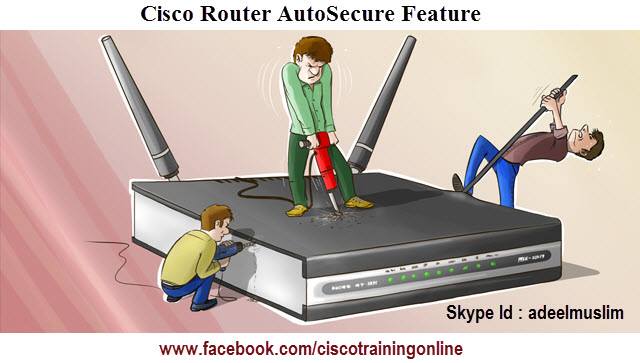To maximize flexibility the Cisco AutoSecure command supports two different modes depending on your needs and flexibility required:
AutoSecure Interactive Mode: This mode prompts the user with options to enable/disable services and other security features supported by the IOS version the router is running.
AutoSecure Non-Interactive Mode: Automatically executes the Cisco AutoSecure command using the recommended Cisco default settings.
1. Disables the following Global Services:
• Finger
• PAD
• Small Servers
• Bootp
• HTTP service
• Identification Service
• CDP
• NTP
• Source Routing
2. Enables the following Global Services:
• Password-encryption service
• Tuning of scheduler interval/allocation
• TCP synwait-time
• TCP-keepalives-in and tcp-kepalives-out
• SPD configuration
• No ip unreachables for null 0
3. Disables the following services per interface:
• ICMP
• Proxy-Arp
• Directed Broadcast
• Disables MOP service
• Disables icmp unreachables
• Disables icmp mask reply messages.
4. Provides logging for security:
• Enables sequence numbers & timestamp
• Provides a console log
• Sets log buffered size
• Provides an interactive dialogue to configure the logging server ip address.
5. Secures access to the router:
• Checks for a banner and provides facility to add text to automatically configure:
• Login and password
• Transport input & output
• Exec-timeout
• Local AAA
• SSH timeout and ssh authentication-retries to minimum number
• Enable only SSH and SCP for access and file transfer to/from the router
• Disables SNMP If not being used
6. Secures the Forwarding Plane:
• Enables Cisco Express Forwarding (CEF) or distributed CEF on the router, when available
• Anti-spoofing
• Blocks all IANA reserved IP address blocks
• Blocks private address blocks if customer desires
• Installs a default route to NULL 0, if a default route is not being used
• Configures TCP intercept for connection-timeout, if TCP intercept feature is available and the user is interested
• Starts interactive configuration for CBAC on interfaces facing the Internet, when using a Cisco IOS Firewall image
• Enables NetFlow on software forwarding platforms




